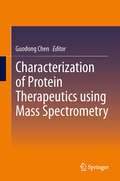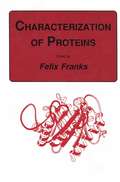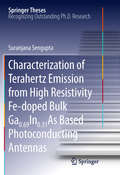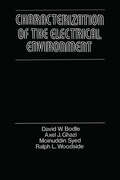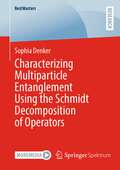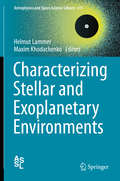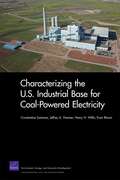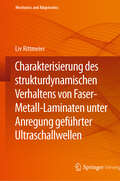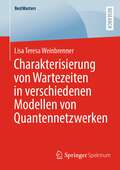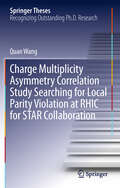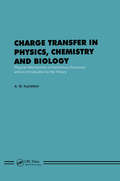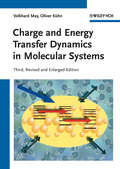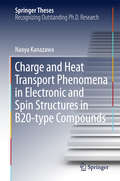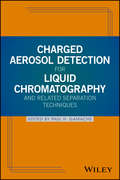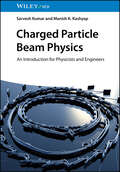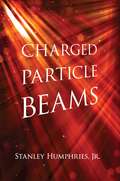- Table View
- List View
Characterization of Protein Therapeutics using Mass Spectrometry
by Guodong ChenThis book highlights current approaches and future trends in the use of mass spectrometry to characterize protein therapies. As one of the most frequently utilized analytical techniques in pharmaceutical research and development, mass spectrometry has been widely used in the characterization of protein therapeutics due to its analytical sensitivity, selectivity, and specificity. This book begins with an overview of mass spectrometry techniques as related to the analysis of protein therapeutics, structural identification strategies, quantitative approaches, followed by studies involving characterization of process related protein drug impurities/degradants, metabolites, higher order structures of protein therapeutics. Both general practitioners in pharmaceutical research and specialists in analytical sciences will benefit from this book that details step-by-step approaches and new strategies to solve challenging problems related to protein therapeutics research and development.
Characterization of Proteins (Biological Methods)
by Felix FranksProteins are the servants of life. They occur in all component parts of living organisms and are staggering in their functional variety, despite their chemical similarity. Even the simplest single-cell organism contains a thousand different proteins, fulfilling a wide range of life-supporting roles. Their production is controlled by the cell’s genetic machinery, and a malfunction of even one protein in the cell will give rise to pathological symptoms. Additions to the total number of known proteins are constantly being made on an increasing scale through the discovery of mutant strains or their production by genetic manipulation; this latter technology has become known as protein engineering. The in vivo functioning of proteins depends critically on the chemical structure of individual peptide chains, but also on the detailed folding of the chains themselves and on their assembly into larger supramolecular structures. The molecules and their functional assemblies possess a limited in vitro stability. Special methods are required for their intact isolation from the source material and for their analysis, both qualitatively and quantitatively. Proteins are also increasingly used as “industrial components,” e.g., in biosensors and immobilized enzymes, because of their specificity, selectivity, and sensitivity. This requires novel and refined processing methods by which the protein isolate can be converted into a form in which it can be utilized.
Characterization of Terahertz Emission from High Resistivity Fe-doped Bulk Ga0.69In0.31As Based Photoconducting Antennas (Springer Theses)
by Suranjana SenguptaTerahertz science and technology is attracting great interest due to its application in a wide array of fields made possible by the development of new and improved terahertz radiation sources and detectors. This book focuses on the development and characterization of one such source - namely the semi-large aperture photoconducting (PC) antenna fabricated on Fe-doped bulk Ga0.69In0.31As substrate. The high ultrafast carrier mobility, high resistivity, and subpicosecond carrier lifetime along with low bandgap make Ga0.69In0.31As an excellent candidate for PC antenna based THz emitter that can be photoexcited by compact Yb-based multiwatt laser systems for high power THz emission. The research is aimed at evaluating the impact of physical properties of a semi-large aperture Ga0.69In0.31As PC antenna upon its THz generation efficiency, and is motivated by the ultimate goal of developing a high-power terahertz radiation source for time-domain terahertz spectroscopy and imaging systems.
Characterization of the Electrical Environment
by Ralph L. Woodside Moninuddin Syed Axel J. Ghazi David BodleA communication system must have adequate electrical protection in order to meet the reliability standards for commercially acceptable service and to keep down maintenance expenses. This report characterizes, from the viewpoint of electrical protection and coordination, the conditions of the electrical environment to which communication facilities are exposed. It gives consideration to both present and anticipated future conditions, and covers such topics as the effects of lightning, interference from power networks, electric shock, earth potential gradients, corrosion, over-voltage in AC power utilization circuits,her and electromagnetic pulses.Characterization of the Electrical Environment is a current reference on the design factors required to ensure reliable performance of communication facilities under field operating conditions. It will be useful as a manual for practicing engineers in telecommunications, and as a tutorial textbook in engineering schools in North America, Europe, and elsewhere.
Characterizing Biotherapeutics: Analytical Methods for Diverse Modalities
by Jennie R. Lill Wendy SandovalProvides detailed and up-to-date coverage of analytical approaches for biologic drug modalities The development of innovative biologic therapies has revolutionized medicine, but their complexity demands equally advanced analytical approaches. Characterizing Biotherapeutics: Analytical Methods for Diverse Modalities introduces the tools and techniques used to analyze these groundbreaking therapies. Designed to help readers characterize and troubleshoot increasingly diverse and sophisticated therapeutic molecules, this in-depth guide addresses different biologic drugs, their unique analytical challenges, and the methods that enable their analysis. Organized into two comprehensive sections, Characterizing Biotherapeutics first delves into the fundamentals of analytical platforms, providing a robust foundation in techniques such as mass spectrometry and biophysical assays. The second section applies these methods to real-world scenarios, focusing on drug discovery, clinical evaluation, and commercial considerations in drug development. Authors Jennie R. Lill and Wendy Sandoval provide clear guidance tailored to the evolving demands of therapeutic innovations such as structural characterization, high-throughput biophysical assays, and RNA-based therapeutics. Equipping researchers with the knowledge to navigate the challenges posed by increasingly complex biologics, Characterizing Biotherapeutics: Analytical Methods for Diverse Modalities: Discusses new and emerging biological molecule diversity and both traditional analytical methods Provides characterization strategies for large molecule (protein/antibody) based therapeutics Summarizes cutting-edge technologies for novel modalities and antibody protein therapeutics Incorporates the latest advancements in mass spectrometry, functional assays, and biophysical methods Addresses specialized analytical issues for membrane proteins and other challenging targets Presents methodologies for assessing safety and therapeutic potential Characterizing Biotherapeutics: Analytical Methods for Diverse Modalities is an essential reference for analytical scientists, biologists, and mass spectrometrists involved in biomolecule analysis. It is also a valuable resource for graduate students taking advanced courses in biotechnology, drug development, and biotherapeutic analysis, as well as professionals in biotechnology and pharmaceutical industries working to advance biotherapeutic research and development.
Characterizing Entanglement and Quantum Correlations Constrained by Symmetry (Springer Theses)
by Jordi Tura i BruguésThis thesis focuses on the study and characterization of entanglement and nonlocal correlations constrained under symmetries. It includes original results as well as detailed methods and explanations for a number of different threads of research: positive partial transpose (PPT) entanglement in the symmetric states; a novel, experimentally friendly method to detect nonlocal correlations in many-body systems; the non-equivalence between entanglement and nonlocality; and elemental monogamies of correlations. Entanglement and nonlocal correlations constitute two fundamental resources for quantum information processing, as they allow novel tasks that are otherwise impossible in a classical scenario. However, their elusive characterization is still a central problem in quantum information theory. The main reason why such a fundamental issue remains a formidable challenge lies in the exponential growth in complexity of the Hilbert space as well as the space of multipartite correlations. Physical systems of interest, on the other hand, display symmetries that can be exploited to reduce this complexity, opening the possibility that some of these questions become tractable for such systems.
Characterizing Groundwater Flow Dynamics and Storage Capacity in an Active Rock Glacier (BestMasters)
by Simon KainzAlpine aquifers play a critical role in the hydrology of mountainous areas by sustaining base flow in downstream rivers during dry periods and retarding flood propagation after heavy precipitation events. Progressing climate change alters climatic and meteorological boundary conditions as well as the hydraulic response of alpine catchments by ablating glaciers and thawing permafrost. Rock glaciers exert a controlling influence on the catchment response due to their prominent groundwater storage and complex drainage characteristics. This thesis investigates the hydrogeology and internal structure of the active rock glacier Innere Ölgrube (Ötztal Alps), which governs catchment runoff and is affected by permafrost degradation. A 3D geometrical model of its internal structure is obtained by combining geophysical data and permafrost creep modelling. Available data and new results are integrated into a conceptual hydrogeological model providing a sound basis for the implementation of a prospective numerical groundwater flow model. Hydraulic properties of the hydrostratigraphic units constituting the rock glacier are estimated and groundwater recharge fluxes quantified. Fundamental properties of the heterogeneous groundwater flow system within the rock glacier are discussed and compared to existing rock glacier studies.
Characterizing Multiparticle Entanglement Using the Schmidt Decomposition of Operators (BestMasters)
by Sophia DenkerCharacterizing entanglement is an important issue in quantum information, as it is considered to be a resource for many applications such as quantum key distribution or quantum metrology. One useful tool to detect and quantify entanglement are witness operators. A standard way to construct them is based on the fidelity of pure states and mathematically relies on the Schmidt decomposition of vectors. In this book a method to build entanglement witnesses using the Schmidt decomposition of operators is presented. One can show that these are strictly stronger than the fidelity witnesses. Moreover, the concept can be generalized easily to the multipartite case, and one may use it to quantify the dimensionality of entanglement. Finally, this scheme will be used to provide two algorithms that can be combined to improve given witnesses for multiparticle entanglement.
Characterizing Space Plasmas: A Data Driven Approach (Astronomy and Astrophysics Library)
by George K. ParksThis didactic book uses a data-driven approach to connect measurements made by plasma instruments to the real world. This approach makes full use of the instruments’ capability and examines the data at the most detailed level an experiment can provide. Students using this approach will learn what instruments can measure, and working with real-world data will pave their way to models consistent with these observations. While conceived as a teaching tool, the book contains a considerable amount of new information. It emphasizes recent results, such as particle measurements made from the Cluster ion experiment, explores the consequences of new discoveries, and evaluates new trends or techniques in the field. At the same time, the author ensures that the physical concepts used to interpret the data are general and widely applicable. The topics included help readers understand basic problems fundamental to space plasma physics. Some are appearing for the first time in a space physics textbook. Others present different perspectives and interpretations of old problems and models that were previously considered incontestable. This book is essential reading for graduate students in space plasma physics, and a useful reference for the broader astrophysics community.
Characterizing Stellar and Exoplanetary Environments (Astrophysics and Space Science Library #411)
by Helmut Lammer Maxim KhodachenkoIn this book an international group of specialists discusses studies of exoplanets subjected to extreme stellar radiation and plasma conditions. It is shown that such studies will help us to understand how terrestrial planets and their atmospheres, including the early Venus, Earth and Mars, evolved during the host star's active early phase. The book presents an analysis of findings from Hubble Space Telescope observations of transiting exoplanets, as well as applications of advanced numerical models for characterizing the upper atmosphere structure and stellar environments of exoplanets. The authors also address detections of atoms and molecules in the atmosphere of "hot Jupiters" by NASA's Spitzer telescope. The observational and theoretical investigations and discoveries presented are both timely and important in the context of the next generation of space telescopes. The book is divided into four main parts, grouping chapters on exoplanet host star radiation and plasma environments, exoplanet upper atmosphere and environment observations, exoplanet and stellar magnetospheres, and exoplanet observation and characterization. The book closes with an outlook on the future of this research field.
Characterizing the Robustness of Science: After the Practice Turn in Philosophy of Science (Boston Studies in the Philosophy and History of Science #292)
by William Wimsatt Emiliano Trizio Léna Soler Thomas NicklesMature sciences have been long been characterized in terms of the "successfulness", "reliability" or "trustworthiness" of their theoretical, experimental or technical accomplishments. Today many philosophers of science talk of "robustness", often without specifying in a precise way the meaning of this term. This lack of clarity is the cause of frequent misunderstandings, since all these notions, and that of robustness in particular, are connected to fundamental issues, which concern nothing less than the very nature of science and its specificity with respect to other human practices, the nature of rationality and of scientific progress; and science's claim to be a truth-conducive activity. This book offers for the first time a comprehensive analysis of the problem of robustness, and in general, that of the reliability of science, based on several detailed case studies and on philosophical essays inspired by the so-called practical turn in philosophy of science.
Characterizing the U.S. Industrial Base for Coal-Powered Electricity
by Henry H. Willis Constantine Samaras Jeffrey A. Drezner Evan BloomTo determine whether the industrial base for the U. S. domestic coal-based electricity generation industry can maintain the capability to design, construct, operate, and maintain coal-fired electricity generating units within reasonable cost, schedule, performance, environmental, and quality expectations, this book reviewsinterviews with stakeholders and data describing key elements of industry capability and validation or verification of concerns.
Charakterisierung des strukturdynamischen Verhaltens von Faser-Metall-Laminaten unter Anregung geführter Ultraschallwellen (Mechanics and Adaptronics)
by Liv RittmeierDas Ziel dieses Buches ist die Charakterisierung und Beschreibung des Ausbreitungsverhaltens geführter Ultraschallwellen (GUW) in Faserverbund-Metall-Laminaten (FML). Sie gliedert sich in drei experimentelle Untersuchungen. Im ersten Experiment wird das Phasenverhältnis der Schwingungen an Strukturober – und -unterseite als Maß für die Ähnlichkeit zu den für isotrope Materialien hergeleiteten Lamb-Wellen untersucht. Dazu erfolgt die Entwicklung eines Verfahrens zum Phasenwinkelvergleich, welches auf der Continuous Wavelet Transformation sowie der Short-Time Fourier-Transformation beruht. Damit kann anhand simulierter Zeitsignalverläufe in verschiedenen Strukturen gezeigt werden, dass sich auch in FML die geführten Wellen wie klassische Lamb-Wellen ausbilden. Auch in einer experimentellen Untersuchung an einem FML kann die Beobachtungen für gleichphasige Schwingungen bestätigt und für Schwingungen mit Phasenversatz geschlussfolgert werden. Im anschließenden Experiment wird die Frage adressiert, wie sich das Wellenausbreitungsverhalten im Inneren von FML verhält. Dazu werden auf piezoelektrischem Polyvinylidenfluorid (PVDF)-basierende Foliensensoren gewählt, die sich aufgrund ihrer geringen Abmaße und ihrer geringen akustischen Impedanz gut für die möglichst rückwirkungsarme Integration in flache Strukturen aus Faserverbundkunststoff (FVK) eignen. Die erwartete Wirkweise der PVDF-Foliensensoren unter GUW-Erfassung wird erklärt. Anschließend erfolgt die experimentelle Untersuchung des FML, in deren Rahmen die Wellenmoden identifiziert werden sowie eine Abschätzung des Verschiebungsfeldverlaufes entlang der Strukturhöhe gegeben wird. Die Ergebnisse liefern einen experimentellen Hinweis auf die Modenkopplung im gewählten Laminataufbau. Das dritte und letzte Experiment liefert den konkreten Anwendungsfall der Schadensdetektion und -charakterisierung in FML. Dazu werden im Rahmen einer Parameterstudie ein Referenzlaminat sowie zwei Laminate mit künstlichen Delaminationen bei ansonsten übereinstimmendem Laminataufbau gefertigt. Ziel ist zum einen die Untersuchung, inwiefern sich eine unterschiedliche relative Höhenlage eines Schadens im Wellenfeld der FML zeigt. Zum anderen soll geprüft werden, inwiefern sich Schadensinformationen über einen integrierten Sensor erfassen lassen. Flächige Vergleichsmessungen an den Plattenoberflächen über ein Laser-Doppler-Vibrometer dienen der Abschätzung der über die integrierten PVDF-Foliensensoren und unterstützen die Auswertung. Es kann gezeigt werden, dass anhand des horizontalen Scherwellenmoden zusätzliche Schadensinformation über den integrierten Sensor gewonnen werden kann. Über Wellenausbreitungsszenarien gelingt es das Auftreten einiger Wellenpakete in den Sensorzeitsignalen über Modenkonversion zu erklären. Es erfolgt eine Zusammenfassung der Ergebnisse sowie ein Ausblick auf mögliche Folgearbeiten zu jedem Experiment.
Charakterisierung von Nanomaterialien in flüssigen dispersen Systemen
by Rodrigo Renato Retamal MarínHäufig liegen natürliche und technische partikuläre Nanomaterialien (NM) in Formulierungen (i.d.R. Suspensionen, Emulsionen oder Suspoemulsionen) und Produkten vor, welche aus mehreren dispersen Phasen und komplexen Dispersionsmedien bestehen. Dabei gilt es, spezifische Grenzflächeneigenschaften der Partikel, ihre Wechselwirkungen untereinander und mit dem Dispersionsmedium zu berücksichtigen. Beispielsweise bestimmen die Grenzflächeneigenschaften, ob sich die Partikel eher in wässriger Phase oder in Lipidphase bzw. an deren Phasengrenzen anordnen. Die Grenzflächeneigenschaften werden maßgeblich durch die Adsorption gelöster Spezies beeinflusst, hängen also von der Zusammensetzung des Dispersionsmediums ab. In dieser Arbeit werden mit theoretischer und empirischer Forschung wie methodischer Vorgehensweise neue Beiträge zur Nanopartikelcharakterisierung erarbeitet. Die notwendige Ausarbeitung von Richtlinien an SOPs für die Charakterisierung von Nanopartikelsystemen wird hierbei berücksichtigt. Diese Richtlinien ermöglichen eine Anwendung im Kontext verschiedenartiger Analyseaufgaben, und die Ergebnisse können dem Leser dieser Arbeit unmittelbar Nutzen bringen.
Charakterisierung von Wartezeiten in verschiedenen Modellen von Quantennetzwerken (BestMasters)
by Lisa Teresa WeinbrennerQuantennetzwerke ermöglichen ähnlich wie klassische Kommunikationsnetzwerke, wie zum Beispiel das Internet, eine Verbindung zwischen potentiell weit entfernten Nutzern. Zu diesem Zweck werden verschränkte Quantenzustände über die einzelnen Verbindungen verteilt und können beispielsweise zur beweisbar sicheren Kommunikation mittels Quantenkryptographie genutzt werden. Quantennetzwerke bestehen aus vielen verschiedenen probabilistischen Bausteinen: Sowohl die Erzeugung verschränkter Zustände als auch deren Übertragung zwischen unterschiedlichen Netzwerkknoten und die Verbindung benachbarter Links entsprechen unterschiedlichen stochastischen Prozessen. In dem vorliegenden Buch werden verschiedene Modellierungsmöglichkeiten dieser Prozesse vorgestellt und verglichen. Das Ziel ist dabei jeweils die Berechnung der Wartezeit bis zur Erzeugung einer Ende-zu-Ende-Verbindung zwischen den Kommunikationspartnern.
Charge Multiplicity Asymmetry Correlation Study Searching for Local Parity Violation at RHIC for STAR Collaboration (Springer Theses)
by Quan WangIt has been suggested that local parity violation (LPV) in Quantum Chromodynamics (QCD) would lead to charge separation of quarks by the Chiral Magnetic Effect (CME) in heavy ion collisions. Charge Multiplicity Asymmetry Correlation Study Searching for Local Parity Violation at RHIC for STAR Collaboration presents the detailed study of charge separation with respect to the event plane. Results on charge multiplicity asymmetry in Au+Au and d+Au collisions at 200 GeV by the STAR experiment are reported. It was found that the correlation results could not be explained by CME alone. Additionally, the charge separation signal as a function of the measured azimuthal angle range as well as the event-by-event anisotropy parameter are studied. These results indicate that the charge separation effect appears to be in-plane rather than out-of-plane. It is discovered that the charge separation effect is proportional to the event-by-event azimuthal anisotropy and consistent with zero in events with zero azimuthal anisotropy. These studies suggest that the charge separation effect, within the statistical error, may be a net effect of event anisotropy and correlated particle production. A potential upper limit on the CME is also presented through this data.
Charge Quantization and Kondo Quantum Criticality in Few-Channel Mesoscopic Circuits (Springer Theses)
by Zubair IftikharThis thesis explores several fundamental topics in mesoscopic circuitries that incorporate few electronic conduction channels. It reports a series of long-awaited experiments that establish a new state of the art. The first experiments address the quantized character of charge in circuits. We demonstrate the charge quantization criterion, observe the predicted charge quantization scaling and a crossover toward a universal behavior as temperature is increased. The second set of experiments addresses the unconventional quantum critical physics that arises in the multichannel Kondo model. We observe the predicted universal Kondo fixed points and validate the numerical renormalization group scaling curves. Away from the quantum critical point, we obtain a direct visualization of the development of a second-order quantum phase transition.
Charge Transfer in Physics, Chemistry and Biology: Physical Mechanisms of Elementary Processes and an Introduction to the Theory
by A.M. KuznetrsovThis book covers the various processes of charge transfer in physics, chemistry and biology and shows the similarities and differences between them. It focuses on the physical mechanisms of the elementary processes to demonstrate their common physical nature.
Charge and Energy Transfer Dynamics in Molecular Systems
by Oliver Kühn Volkhard MayCharge and Energy Transfer Dynamics in Molecular Systems Comprehensive resource offering knowledge on charge and energy transfer dynamics in molecular systems and nanostructures Charge and Energy Transfer Dynamics in Molecular Systems provides a unified description of different charge and energy transfer phenomena in molecular systems with emphasis on the theory, bridging the regimes of coherent and dissipative dynamics and thus presenting classic rate theories as well as modern treatments of ultrafast phenomena. Starting from microscopic models, the common features of the different transfer processes are highlighted, along with applications ranging from vibrational energy flow in large polyatomic molecules, the motion of protons in solution, up to the concerted dynamics of electronic and nuclear degrees of freedom in molecules and molecular aggregates. The newly revised and updated Fourth Edition contains a more detailed coverage of recent developments in density matrix theory, mixed quantum-classical methods for dynamics simulations, and a substantially expanded treatment of time-resolved spectroscopy. The book is written in an easy-to-follow style, including detailed mathematical derivations, thus making even complex concepts understandable and applicable. Charge and Energy Transfer Dynamics in Molecular Systems includes information on: Electronic and vibrational molecular states, covering molecular Schrödinger equation, Born—Oppenheimer separation and approximation, Hartree-Fock equations and other electronic structure methods Dynamics of isolated and open quantum systems, covering multidimensional wave packet dynamics, and different variants of density operator equations Interaction of molecular systems with radiation fields, covering linear and nonlinear optical response using the correlation function approach Intramolecular electronic transitions, covering optical transition and internal conversion processes Transfer processes of electrons, protons, and electronic excitation energy Providing in-depth coverage of the subject, Charge and Energy Transfer Dynamics in Molecular Systems is an essential resource for anyone working on timely problems of energy and charge transfer in physics, chemistry and biophysics as well as for all engaged in nanoscience and organic electronics.
Charge and Energy Transfer Dynamics in Molecular Systems: A Theoretical Introduction
by Oliver Kühn Volkhard MayThis 3rd edition has been expanded and updated to account for recent developments, while new illustrative examples as well as an enlarged reference list have also been added. It naturally retains the successful concept of its predecessors in presenting a unified perspective on molecular charge and energy transfer processes, thus bridging the regimes of coherent and dissipative dynamics, and establishing a connection between classic rate theories and modern treatments of ultrafast phenomena. Among the new topics are: - Time-dependent density functional theory - Heterogeneous electron transfer, e.g. between molecules and metal or semiconductor surfaces - Current flows through a single molecule. While serving as an introduction for graduate students and researchers, this is equally must-have reading for theoreticians and experimentalists, as well as an aid to interpreting experimental data and accessing the original literature.
Charge and Heat Transport Phenomena in Electronic and Spin Structures in B20-type Compounds (Springer Theses)
by Naoya KanazawaThis thesis presents systematic experimental research on chiral-lattice crystals referred to as B20-type germanium compounds, especially focusing on skyrmion spin textures and Dirac electrons. An emergent electromagnetic field observed in MnGe demonstrates a formation of three-dimensional skyrmion crystals. Detection of skyrmions in nanoscale Hall bar devices made of FeGe is realized by measuring the topological Hall effect, a transport property reflecting emergent fields produced by skyrmions. By measuring the electron-filling dependence of thermopower in CoGe, a pronounced thermoelectric property in this compound is revealed to stem from the asymmetric density of states appearing at certain levels of Fermi energy in the Dirac electron state. The three main results named above will contribute to enriching a variety of novel electromagnetic responses of emergent gauge fields in solids, to realizing high-performance skyrmion-based magnetic memory, and to designing high-efficiency thermoelectric materials, respectively.
Charge and Spin Transport in Disordered Graphene-Based Materials (Springer Theses)
by Dinh TuanThis thesis presents an in-depth theoretical analysis of charge and spin transport properties in complex forms of disordered graphene. It relies on innovative real space computational methods of the time-dependent spreading of electronic wave packets. First a universal scaling law of the elastic mean free path versus the average grain size is predicted for polycrystalline morphologies, and charge mobilities of up to 300. 000 cm2/V. s are determined for 1 micron grain size, while amorphous graphene membranes are shown to behave as Anderson insulators. An unprecedented spin relaxation mechanism, unique to graphene and driven by spin/pseudospin entanglement is then reported in the presence of weak spin-orbit interaction (gold ad-atom impurities) together with the prediction of a crossover from a quantum spin Hall Effect to spin Hall effect (for thallium ad-atoms), depending on the degree of surface ad-atom segregation and the resulting island diameter.
Charged Aerosol Detection for Liquid Chromatography and Related Separation Techniques
by Paul H. GamacheThe first book devoted exclusively to a highly popular, relatively new detection technique Charged Aerosol Detection for Liquid Chromatography and Related Separation Techniques presents a comprehensive review of CAD theory, describes its advantages and limitations, and offers extremely well-informed recommendations for its practical use. Using numerous real-world examples based on contributors’ professional experiences, it provides priceless insights into the actual and potential applications of CAD across a wide range of industries. Charged aerosol detection can be combined with a variety of separation techniques and in numerous configurations. While it has been widely adapted for an array of industrial and research applications with great success, it is still a relatively new technique, and its fundamental performance characteristics are not yet fully understood. This book is intended as a tool for scientists seeking to identify the most effective and efficient uses of charged aerosol detection for a given application. Moving naturally from basic to advanced topics, the author relates fundamental principles, practical uses, and applications across a range of industrial settings, including pharmaceuticals, petrochemicals, biotech, and more. Offers timely, authoritative coverage of the theory, experimental techniques, and end-user applications of charged aerosol detection Includes contributions from experts from various fields of applications who explore CAD’s advantages over traditional HPLC techniques, as well its limitations Provides a current theoretical and practical understanding of CAD, derived from authorities on aerosol technology and separation sciences Features numerous real-world examples that help relate fundamental properties and general operational variables of CAD to its performance in a variety of conditions Charged Aerosol Detection for Liquid Chromatography and Related Separation Techniques is a valuable resource for scientists who use chromatographic techniques in academic research and across an array of industrial settings, including the biopharmaceutical, biotechnology, biofuel, chemical, environmental, and food and beverage industries, among others.
Charged Particle Beam Physics: An Introduction for Physicists and Engineers
by Sarvesh Kumar Manish K. KashyapOffers a clear and practical introduction to the essentials of charged particle beam physics, covers the design of accelerator machines and their basic components A cornerstone of modern accelerator technology, charged particle beam physics encompasses theoretical principles, advanced simulations, and real-world applications. Charged Particle Beam Physics: An Introduction for Physicists and Engineers provides a comprehensive foundation for understanding, modeling, and implementing beam optics components in accelerator systems. Combining essential concepts with cutting-edge techniques, such as the transfer-matrix method and numerical simulation tools, this detailed yet accessible textbook simplifies the core concepts and principles of the complex field. Reader-friendly chapters systematically address ion sources, beam optics design, advanced diagnostic and vacuum systems, and more. Authors Sarvesh Kumar and Manish K. Kashyap discuss key topics such as electrostatic, magnetostatic, and radiofrequency fields, as well as practical applications in materials science, plasma physics, and radiation biology. Bridging theoretical knowledge with practical implementation, Charged Particle Beam Physics: Provides in-depth coverage of charged particle beam physics, relevant to both single-pass configurations and standard beam transport lines across accelerator systemsCombines elements of electrodynamics, particle physics, optics, and engineering for a holistic understandingExplores state-of-the-art methods such as open-source beam optics codesIncludes end-of-chapter problems and worked solutions, along with numerical examples using open-source tools such as TRANSPORT and TRACE3d Charged Particle Beam Physics: An Introduction for Physicists and Engineers is ideal for graduate-level students in physics and engineering courses focused on accelerator physics and beam optics, as well as researchers and professionals working in accelerator design and operation. It serves as both a teaching resource and a reference for practitioners tackling fundamental calculations and developing accelerator components across various disciplines.
Charged Particle Beams (Dover Books On Physics Series)
by Stanley Humphries Jr.Detailed enough for a text and sufficiently comprehensive for a reference, this volume addresses topics vital to understanding high-power accelerators and high-brightness-charged particle beams. Subjects include stochastic cooling, high-brightness injectors, and the free electron laser. Humphries provides students with the critical skills necessary for the problem-solving insights unique to collective physics problems. 1990 edition.
